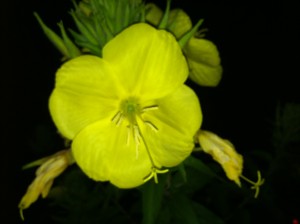There are over 100 species of evening primroses (Oenothera spp.) worldwide, several native to the U.S. The night-blooming evening primrose (O. glazioviana) is a great reason to plan more parties. Invite friends and neighbors, including children of all ages, although you may keep them up past their normal bedtime hour. This night blooming hardy biennial or perennial (USDA hardiness zone 3 to 7) is native to Southern and central United States.
The cultivar ‘Tina James’, identified as “Lamarck evening primrose” is very popular and available from seed. It is named for Tina James, a Maryland garden writer, who hosts numerous primrose parties. The plant thrives in full sun and in a moist, compost-rich, well-drained soil. An established plant will tolerate poor and/or limey soils, drought, and light shade. A plant in too much shade tends to become leggy and require staking.
Each 3-inch wide four-petalled flower bursts open rapidly, usually in less than one minute. Time is slightly after dusk from mid-June to early July. The lightly fragrant yellow blooms are very showy until mid-morning. A 3-year established evening primrose grows into a bushy 3 to 5 feet tall herbaceous plant.
Evening primrose is a prolific seeder, likely around the mother plant. In the first year plant develops a flat rosette of leaves (similar to an African violet or strawberry plant). It initiates 3-5 feet tall yellow spires in its second year. Flowers are pollinated by night-flying moths and hummingbirds. Stage it growing in a container on your deck or patio and it will become a great conversation piece among your guests.
Night blooming evening primrose is reported to have medicinal properties that are not discussed here. It has no serious insect or disease problems.


 Posted in
Posted in 
